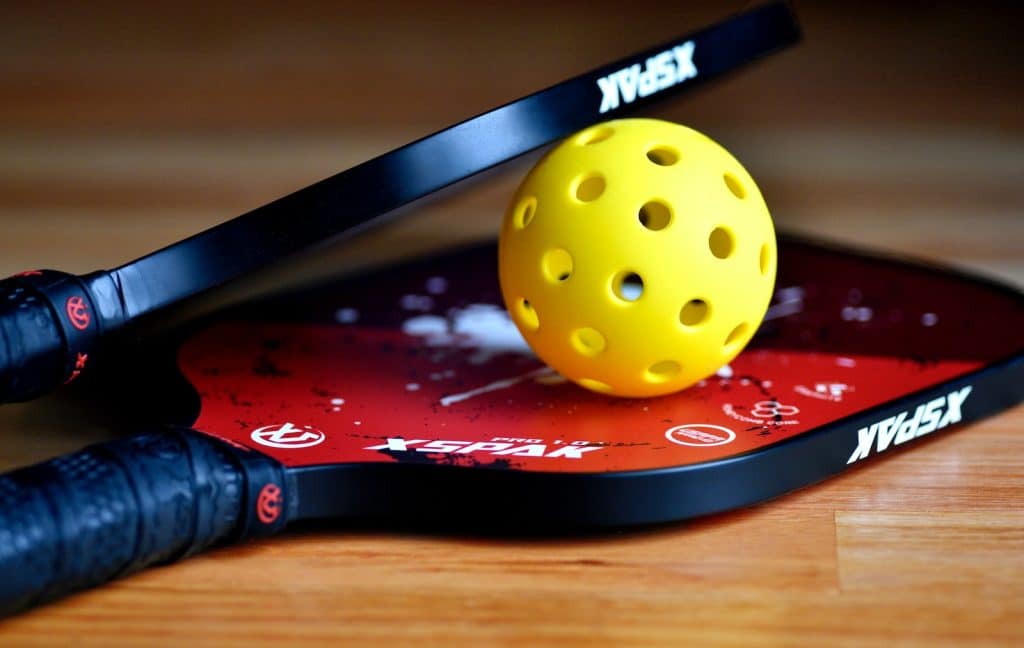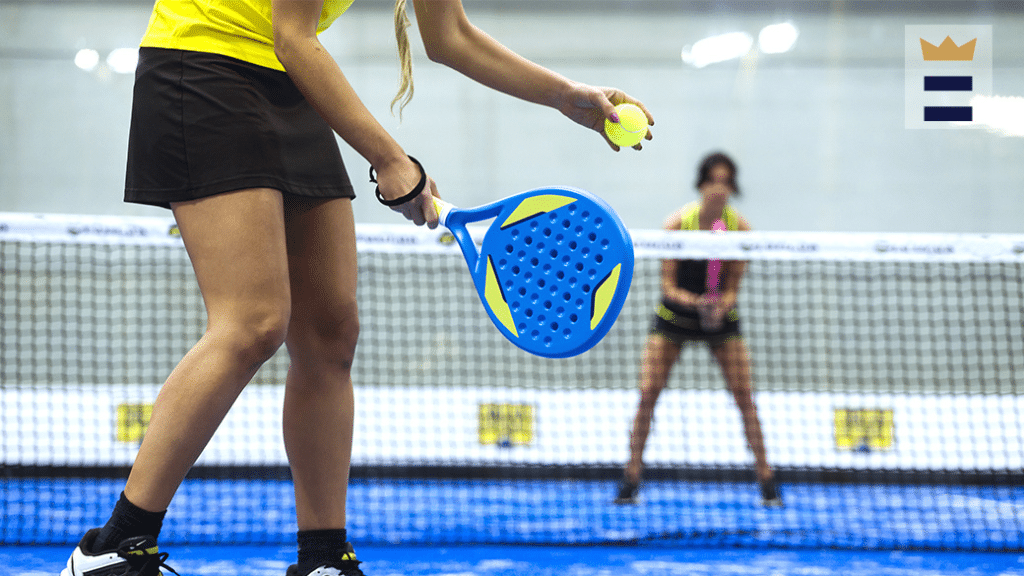Pickleball is one of the fastest growing sports in America, but many new players struggle with the nuances of the non-volley zone, commonly referred to as the “kitchen.” This 14-foot section – extending 7 feet on either side of the net – is governed by specific kitchen rules that make pickleball unique. While the kitchen may seem tricky at first, understanding these pickleball kitchen rules is key to avoiding faults and becoming a true pickleball aficionado.
Mastering the kitchen’s rules will give you a competitive edge on the court and let you fully appreciate the strategy of this beloved sport. Let’s break it down.
Table of Contents
What is the Kitchen in Pickleball?
The kitchen refers to the non-volley zone (NVZ) on a pickleball court. It is a 7-foot section of the court closest to the net on both sides. Pickleball court lines are 2 inches thick, and the kitchen line is included as part of the kitchen. The kitchen is an important part of the court, as volleying is prohibited within this zone. The kitchen rules in pickleball dictate how this section can be used.
Why is it Called the Kitchen?
The origins of the name “kitchen” can be traced back to the early days of pickleball. The wife of one of the sport’s founders likened the non-volley zone to a kitchen in the house – you’re allowed to go in there, but you can’t hang out too long! The comparison stuck, and pickleball zones became known as “kitchens.”
Pickleball Kitchen Dimensions
The standard kitchen is 7 feet deep, stretching from the net to the kitchen line on each side of the court. The kitchen line is parallel to the net, 7 feet back. Kitchens are identical on both sides of the net.
In doubles play, the kitchen spans the entire width of the court, from sideline to sideline. In singles play, the kitchen only extends halfway across the court, leaving an open section in the middle.
Key Pickleball’s Non-Volley Zone Rules
The kitchen is governed by important non-volley zone rules that every player must know. Here are the key regulations:
You Cannot Volley in the Kitchen
The defining kitchen rule is that you cannot hit a volley shot when any part of your body or anything you’re holding (paddle, clothing, etc.) is touching the kitchen zone. Your paddle face cannot cross the plane of the kitchen at any time during a volley.
This means you must allow the ball to bounce before hitting a return shot from inside the kitchen. You can enter the kitchen after the ball bounces.
Your Feet Must be Outside the Kitchen
Both feet must be firmly on the ground outside of the kitchen lines prior to hitting a volley shot. If any part of your foot touches the kitchen line or inside the kitchen, it is a fault.
Wheelchair players must keep their front two wheels out of the kitchen when volleying. Rear wheels can be inside the kitchen during a volley shot.
The Kitchen Line is Part of the Kitchen
The lines themselves are considered part of the kitchen. If any part of your foot touches the line during a volley, it constitutes being in the kitchen and is a fault.
No Equipment or Clothing in the Kitchen
Not only must your feet and body be outside the kitchen when volleying, but also any equipment or clothing as well. Your paddle, its edges, your shoes, shoelaces, hat, and any other items cannot cross into the kitchen zone during a volley swing, even if you remain outside.
Serving and the Kitchen
On the serve, the ball can land on but not inside the kitchen lines. The server’s feet cannot touch inside kitchen when the serve is hit.
If you throw the ball up for a serve with your feet inside the kitchen and then step outside the kitchen to hit, it is still a fault. Your feet must be fully outside the kitchen when starting and hitting a pickleball serve.
Hitting the Ball in Pickleball
Let’s discuss some basics around hitting the ball in pickleball:
Groundstrokes vs Volleys
Groundstrokes are hits after the ball has bounced, while volleys are hits in mid air before the ball bounces. The kitchen rules apply primarily to volleys.
Forehand and Backhand Hits
Forehand hits are made on the paddle side matching your dominant hand. Backhand hits use the reverse side of the paddle. Master both forehand and backhand hits for optimal court coverage.
Making Contact with the Ball
It’s important to ensure no part of your body or paddle makes contact with the ball until it has passed the plane of the kitchen when volleying. Keep your paddle and body fully out of the kitchen when making contact with the ball in midair.
What You Can Do in the Kitchen
While volleying is prohibited in the kitchen, players can certainly enter the kitchen zone under certain conditions:
Moving Through the Kitchen
Players can move into the kitchen at any time as long as they do not hit the ball while inside. You can run through the kitchen to return a shot and exit out the other side.
The key is that the volley itself cannot be hit from the kitchen. You must let the ball bounce before striking it inside the kitchen lines.
Dinking in the Kitchen
You are permitted to hit dink shots from inside the kitchen. Dinking involves hitting soft shots that land close to the net inside the kitchen. This gives players near the kitchen line more shot options.
Dinks are designed to just clear the net, dropping down into the non-volley zone. It is hit with a volley motion but without as much force. You can dink from any part of the kitchen as long as the ball has bounced.
Purpose of the Pickleball Non-Volley Zone
The kitchen serves some important functions in pickleball:
- Prevents players from “camping” at the net and slamming volleys. Forces players to move back from the net.
- Adds strategy by requiring players to retreat out of the kitchen in order to hit a legal volley.
- Allows dinking near the net as an option to keep the ball in play.
- Creates defined areas of the court for different types of shots.
Common Pickleball Kitchen Rule Questions
There are some gray areas surrounding kitchen rules that often lead to questions. Let’s clarify a few key points:
Momentum Carrying You Into the Kitchen
If momentum from a volley shot carries you into the kitchen, it is not a fault as long as your volley was hit fully outside the kitchen. This momentum exception applies to your feet only, not your paddle or arms.
For example, you can legally hit a volley while standing outside the kitchen, and carry your momentum forward into the kitchen after striking the ball. But no part of your paddle or arm could cross the kitchen plane during the volley swing.
Jumping and Landing in the Kitchen
You are permitted to jump up for a volley shot and land inside the kitchen, as long as you were fully outside the kitchen when you hit the shot in mid air. Your feet are not considered touching the kitchen in this case while airborne.
This allows you to jump and smash overheads that bounce into the kitchen, for example. Just be sure no part of your body or paddle touches the kitchen before hitting the volley.
Reaching Over the Kitchen Line
You cannot reach your arm or paddle over the kitchen line during a volley swing, even if your feet remain outside the kitchen. Your paddle must stay completely on the outside of the line when hitting a volley.
Wheelchair Kitchen Rules
Wheelchair pickleball includes some adapted kitchen rules:
- Only the front two wheels must stay out of the kitchen when hitting a volley while off the court surface. The rear wheels can be inside the kitchen.
- The paddle may cross the vertical plane of the kitchen, but the player’s arm cannot when making contact with the ball.
- Dinking is allowed from inside the kitchen.
These exceptions make the game more equitable for wheelchair players. The front-wheel rule mirrors the foot position requirement.
More Pickleball Kitchen Scenarios
Let’s explore a few more examples related to the kitchen:
Volleying Near the Kitchen
When hitting volleys near the kitchen line, be careful not to let your momentum carry any part of your body or paddle over the line. Keep feet planted while standing outside the kitchen when striking the ball.
Hitting the Ball Before It Bounces
You are not allowed to hit the ball before it bounces while standing inside the kitchen. Let the ball bounce once before striking it from the kitchen area.
Returning the Ball From Inside the Kitchen
After your opponent hits a groundstroke that bounces inside the kitchen, you can move into the kitchen and return the ball. But you must allow it to bounce again before hitting your next shot.
Serving While Touching the Pickleball Kitchen
Throwing up the ball for a serve while standing in the kitchen is illegal. Also, no part of your feet can touch the kitchen line or inside the kitchen as you swing and hit the pickleball serve.
Volleying Near the Net
When volleying close to the net, be aware of your proximity to the kitchen line. Make sure to keep all body parts and equipment outside the kitchen when striking volleys.
Conclusion
With this comprehensive guide to pickleball’s kitchen rules, you can step onto the court confident you know the boundaries of the non-volley zone. From the dimensions of the pickleball kitchen to special scenarios involving momentum and jumping volleys, we’ve covered the key regulations and advanced moves needed to avoid faults.
Remember, proper knowledge of these pickleball kitchen rules is critical as more players take up this fast-growing sport of pickleball. Review the kitchen guidelines before your next game to give yourself the competitive edge against opponents. Now grab your paddle and get ready to work on your dinking and volley skills from outside the kitchen lines!



